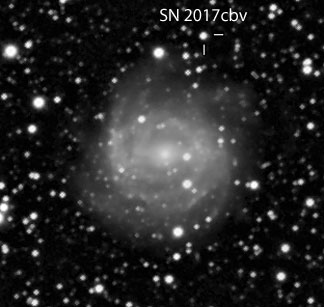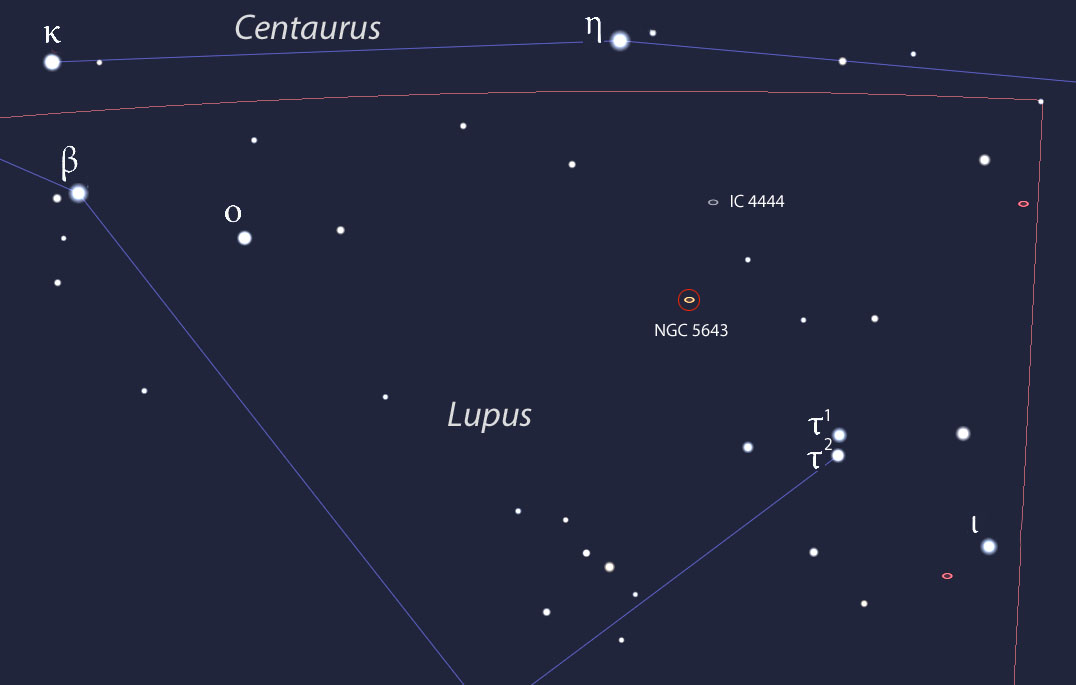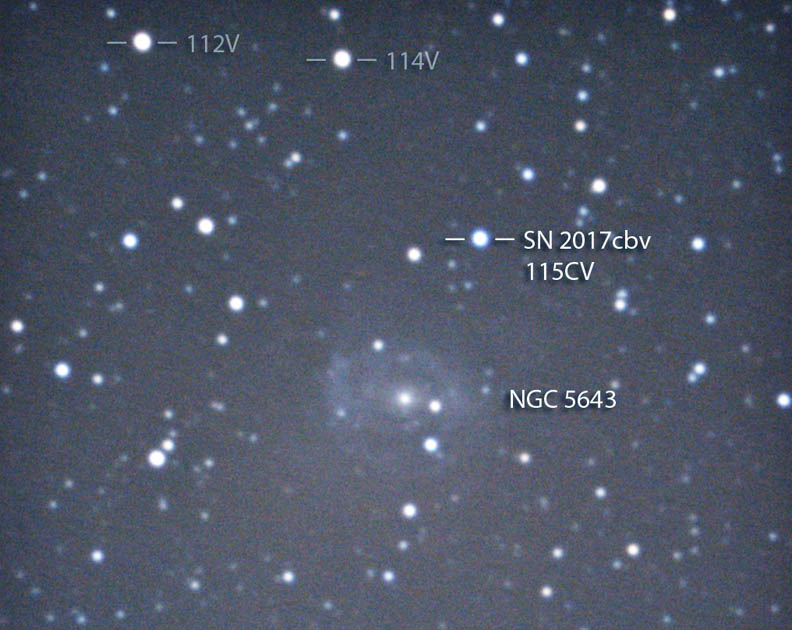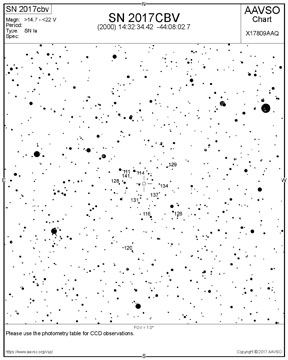A recently discovered supernova in Lupus now shines around magnitude +11.5, bright enough to see in a modest telescope. With photos and maps, we'll get you there.

Joseph Brimacombe
I wished I lived in Georgia and not just for the peach trees and warmer weather. No, I'd be able to get up early tomorrow morning to marvel at a new, bright supernova too far south to see from my home in northern Minnesota.
Supernova 2017cbv in the spiral galaxy NGC 5643 was discovered by a team of astronomers on March 10 during the D<40 Mpc (DLT40) supernova search. NGC 5643 lies 55 million light years from Earth and sits in the far western corner of the constellation Lupus. At discovery, the stellar explosion was only magnitude +15, but in recent days it's brightened to magnitude +11.5 and is now within easy reach of a 6-inch telescope.
Spectra indicate this so-far brightest supernova of the year is a Type Ia, the aftermath of the explosion of a white dwarf star in a doomed relationship with a close companion sun. After millennia of siphoning material from the companion to its surface, the dwarf exceeded the Chandrasekhar Limit of 1.4 solar masses and underwent uncontrolled gravitational collapse. Dire consequences followed as a runaway fusion reaction from the crushing heat and pressure raced through the star, destroying it in one titanic blast.

Credit: NASA / CXC / M. Weiss
Now you can see the magnificent explosion with your own eyes simply by setting your alarm clock to 2:30 in the morning, pointing your telescope to NGC 5643 and using the maps and photos to pinpoint the supernova. You can also check for updated photos and magnitude estimates at two of my favorite sites: Dave Bishop's Bright Supernovae and the AAVSO (Just type in SN 2017cbv in the Pick a Star box).

Created with Stellarium
About the only thing required besides a telescope to see the new object is living in a southern clime. NGC 5643 lies at declination –44°08′. Assuming a minimum altitude of 10° to find the galaxy and track down the star, observers located at 36° north latitude and south should be able to see it. This includes the southern and southwestern states Alabama, Georgia, Florida, Texas, Arizona and southern California. If you're unsure of your latitude, click here to find it.

Guillermo Abramson
To find SN 2017cbv, your observing site should have wide open view of the southern sky. NGC 5643 transits the meridian in Lupus around 3 a.m. local time, so plan your observing session a little before that. The galaxy is located 2° SSW of second magnitude Eta Centauri, and the supernova is found at R.A. 14h 32′ 34″, declination –44°08′ 68″ east and 145″ north of the galaxy's nucleus.

AAVSO
Once you've brought the galaxy into the field of view, use the photographs and a magnification of around 100x to star-step your way from the center of the galaxy northeast to the supernova. I think you'll find the two 11th magnitude stars very helpful in nailing it.
SN 2017cbv isn't the first white dwarf to flame out in NGC 5643. SN 2013aa, another Type Ia, blew its top in early 2013 and peaked at magnitude +11.3 in February that year.
While some of us will never get to see the "new star" because of where we live, I know that a few of you will. Let us know what you see!
 17
17









Comments
March 26, 2017 at 2:30 am
Hi Bob,
Using Stellarium, from the greater San Diego area, I think we have a small effective window of viewing time per night (depending on terrain) as the peak altitude is perhaps 10 degrees in the due South? I expect to be viewing from the San Diego mountains or Borrego desert around April 18-22. Agua Caliente is usually a very good viewing site but the immediate hills would probably block this one. Anyone hoping to see this should probably head for terrain where the Southern sky has a clear view to the horizon. I hope this is helpful.
Best,
David
You must be logged in to post a comment.
Bob KingPost Author
March 26, 2017 at 10:14 am
Hi David,
You're absolutely right about finding a good, clear view to the south.
You must be logged in to post a comment.
Walter Clayton
March 26, 2017 at 8:20 am
Bob, we wish you lived in Georgia too, but, I don't think you would be able to see the SN here.
For the last month, we've only had the Moon, or, Clouds. not much in between.
And as warmer weather approaches, the atmosphere will become more like a rich pea-soup, instead of air.
But, come visit all the same!
Walter Clayton
Savannah, GA
You must be logged in to post a comment.
Bob KingPost Author
March 26, 2017 at 10:11 am
Walter,
Well, thank you for the invite all the same. Good news though -- all it has to do is clear up for one overnight because at least the Moon is finally out of the morning sky. Good luck, sir!
You must be logged in to post a comment.
douglask
March 26, 2017 at 3:41 pm
One of the inset captions has " .. a thermonuclear explosion ensures .. ". That should be "ensues".
The supernova appears galactic, as in the Milky Way. What evidence is there for it being a member of NGC 5643?
You must be logged in to post a comment.
Bob KingPost Author
March 26, 2017 at 3:46 pm
Hi Doug,
Thanks for pointing out the typo -- now fixed! Based on spectra and follow-up observations, it's a Type Ia supernova near the peak of its light curve. There are so many stars in the field of the galaxy, it looks like another ordinary Milky Way star but indeed it's a supernova 55 million light years in the background!
You must be logged in to post a comment.
douglask
March 26, 2017 at 7:31 pm
Do you have links for the follow-up observations? I ask because that star would be so far in that galaxy's outskirts ..
Comparison of Lupus' starfield of course is a good starting point, and I'm sure that figured in ruling it out as a Milky Way star.
You must be logged in to post a comment.
Bob KingPost Author
March 26, 2017 at 10:20 pm
Hi Doug,
Many supernovae appear closer to the host galaxy's nucleus, but not always. I've seen a few SNs way out in the boonies -- it's not uncommon. Here are links with confirmation and classification: 1. http://www.astronomerstelegram.org/?read=10158 2. http://www.astronomerstelegram.org/?read=10164 3. http://www.astronomerstelegram.org/?read=10167
You must be logged in to post a comment.
douglask
March 27, 2017 at 8:35 am
Thanks, Bob.
"The spectrum is consistent with a SN Ia 2 weeks or more before maximum light at the redshift of the host galaxy .. "
http://www.astronomerstelegram.org/?read=10164
You must be logged in to post a comment.
Bob KingPost Author
March 27, 2017 at 10:40 am
You're welcome, Doug. I hope you're in a place where you might get to observe this, too.
You must be logged in to post a comment.
Graham-Wolf
March 26, 2017 at 9:05 pm
Hi Bob
A nice juicy SN... and not far from Eta Centauri.
Don't know how you pulled it off.... BUT....
A big "Thank You" from us Southerners, down here in the Antipodes!
Definitely worth a look at.
NIce AAVSO Chart to help the observers, too!
Great work, Bob.
Regards from 46 South, NZ (Home of the LMC and the SMC, The Southern Cross, and....).
Graham W. Wolf.
You must be logged in to post a comment.
Bob KingPost Author
March 26, 2017 at 10:24 pm
Graham,
I thought of you when I wrote it up. About time I took a trip to the south!
You must be logged in to post a comment.
SNH
March 29, 2017 at 5:10 pm
Oh, wow!! I love supernovas - but bummed that you won't get to see it even though you alerted me to it! So sorry about that. I'll have to send you a drawing of it. I'm at 36.1 degrees N in northern Arkansas, so the galaxy might not be even visible, but the SN should be. Next clear morning for me might be April 1st, but this better not be joke!! I love you so much...you're a real friend for alerting us to it even though you probably won't see it.
Thanks,
Scott N. Harrington
You must be logged in to post a comment.
Feijo
April 2, 2017 at 9:56 am
Hi Bob,
Thank you for such an informative and timely article! I was unaware os this SN and your heads-up notice made me search for it. I live at 30 degrees latitude south, in Brazil. So I was very excited to know of this brightest SN of the year so far, and so conveniently located for us here in the southern hemisphere. Using your guidelines, I found it easily last evening. It is pretty high above the treetops at 10 pm. I even managed to take a picture of it, using just a 80 mm short-focus refractor and an old/basic CCD camera. I was amazed that using such a simple equipment I could photograph this gigantic blast so far away! If you wish I can send you my humble picture.
Again, thank you very, very much.
Best Regards,
Fábio Feijó
You must be logged in to post a comment.
Bob KingPost Author
April 2, 2017 at 10:43 am
Dear Fábio,
I'm happy to know you were successful in finding the supernova AND getting a picture! I'd love to see the photo. My e-mail is: [email protected]
You must be logged in to post a comment.
SNH
April 4, 2017 at 4:12 pm
Hey Bob,
I saw the supernova on the morning of April 1st in my 10-inch SCT and estimated its magnitude at +11.3 to +11.5 (it was tough due to the twinkling of it and the comparison stars at that low of an altitude). I thank you heartily for putting such a nice article together so soon to alert those of us who observe at 36° N and further south (I’m at 36.1°). My skies were so good that morning that if I had the same one and lived in northern Missouri, I’m sure I could have seen it in my 10-inch SCT. Now I can say I've seen three supernovas! I'm still waiting for one to get above magnitude +11 enough so that I might be able to see it in my 8x56 binoculars - that would be so cool! Thanks again for the prompt article.
Scott, in Arkansas
You must be logged in to post a comment.
Bob KingPost Author
April 4, 2017 at 8:27 pm
SNH,
You're welcome! Nice to know the SN's still hanging in there.
You must be logged in to post a comment.
You must be logged in to post a comment.